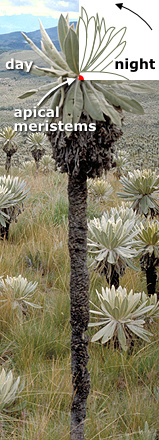Water and leaf structure
Are alpine plants more "hairy"?
Structures often assumed to be designed to reduce vapour loss may in fact have very different functions. Trichomes and furrows create a buffered air space which reduces short term oscillation of ambient vapour pressure deficit and thus prevent overreaction of stomata. Both structures may protect stomata from direct wetting and thus keep the diffusion path open. They also prevent pathogen spores at the leaf surface from getting wet (and sprouting). Trichomes also deter some leaf herbivores.
Note:
- Most mountain plants are not very hairy (pubescent).
- If they are, this has to do with preventing leaf wetting and reflecting excessive solar radiation.
- In connection with leaf movements pubescence can contribute to protecting sensitive apical meristems from night time radiative cooling as in tropical giant rosettes (Fig. 2).

Furrowed leaves are common in Ericaceae and festucoid graminoids. However, these furrows are often filled with trichomes, with the stomata underneath often protruding from (elevated) rather than sinking into the epidermis, as one would expect in a drought avoidance strategy. It is plausible to assume that these structures are related to repelling water. Liquid water can block gas diffusion.

